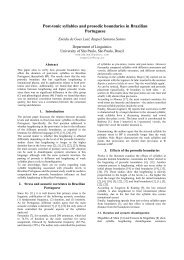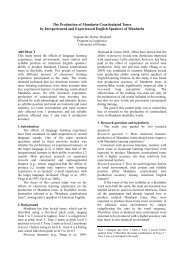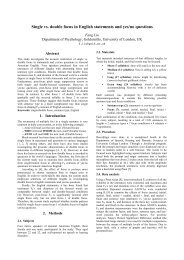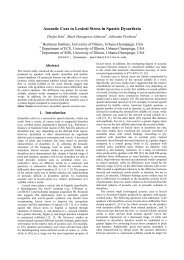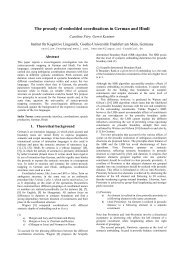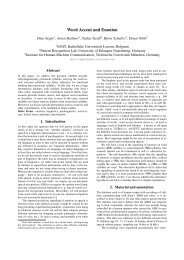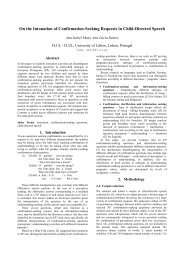C-PROM: An Annotated Corpus for French Prominence ... - GBIF.ch
C-PROM: An Annotated Corpus for French Prominence ... - GBIF.ch
C-PROM: An Annotated Corpus for French Prominence ... - GBIF.ch
Create successful ePaper yourself
Turn your PDF publications into a flip-book with our unique Google optimized e-Paper software.
contains silent pauses (resulting from the semi-automatic<br />
alignment), audible breaths and “junk”, i.e. part of the<br />
recording that could not be transcribed (noise, laughter,<br />
coughing, overlapping, etc.). These could interfere with the<br />
automatic processing of the signal.<br />
3.3. <strong>An</strong>notation task<br />
It took the two transcribers nearly a year to annotate the whole<br />
corpus (the annotation was done between fall 2007 and fall<br />
2008). First, they jointly annotated in a practice session a<br />
small stret<strong>ch</strong> of spee<strong>ch</strong> (a 1-minute long map task). They then<br />
independently annotated the whole corpus, genre by genre.<br />
Ea<strong>ch</strong> time the coding of one sub-corpus (a set of samples from<br />
one genre) had been completed, a comparison tier was<br />
automatically generated. It revealed the full range of<br />
disagreement in coding; the agreed codes were left untou<strong>ch</strong>ed<br />
(see COMPARE-tier in Figure 1). Then the two experts<br />
discussed divergences during a joint session. Due to lack of<br />
space, we cannot address here how the coding divergences<br />
were resolved. See [6] and [19] <strong>for</strong> a systematic analysis of the<br />
inter-transcriber disagreement cases.<br />
3.4. Evaluation of the inter-annotator agreement<br />
The COMPARE-tier was used to estimate the degree of<br />
agreement between the two annotators. Table 2 gives the intertranscriber<br />
agreement <strong>for</strong> ea<strong>ch</strong> recording of the corpus, based<br />
on a count of the intervals involving a conflict between a<br />
“P/p” symbol versus anything else:<br />
Table 2: Inter-annotator consistency: name of the file<br />
(see Table 3), n00/n11: syllables annotated 0 (non<br />
prominent) and p (prominent) by both annotators,<br />
n10/n01: syllables annotated p by one transcriber, 0<br />
by the other; R: recall; P: precision; F: F-measure,<br />
K: Kappa-score<br />
Files n00 n11 n10 n01 R P F K<br />
lec-be 495 87 22 5 94.6 79.8 86.6 0.84<br />
lec-<strong>ch</strong> 390 156 26 33 82.5 85.7 84.1 0.77<br />
lec-fr 469 120 32 2 98.4 78.9 87.6 0.77<br />
pol-be 225 139 21 26 84.2 86.9 85.5 0.76<br />
pol-<strong>ch</strong> 735 162 20 97 62.5 89 73.5 0.66<br />
pol-fr 519 143 13 71 66.8 91.7 77.3 0.70<br />
jpa-be 924 259 58 29 89.9 81.7 85.6 0.81<br />
jpa-<strong>ch</strong> 587 172 29 50 77.5 85.6 81.3 0.75<br />
jpa-fr 668 197 25 46 81.1 88.7 84.7 0.80<br />
cnf-be 727 182 26 84 68.4 87.5 76.8 0.70<br />
cnf-<strong>ch</strong> 586 186 40 59 75.9 82.3 79 0.71<br />
cnf-fr 776 239 39 37 86.6 86 86.3 0.82<br />
int-be 722 224 48 44 83.6 82.4 83 0.77<br />
int-fr 899 262 56 72 78.4 82.4 80.4 0.74<br />
iti-01 124 26 9 2 92.9 74.3 82.5 0.78<br />
iti-02 84 41 1 1 97.6 97.6 97.6 0.96<br />
iti-03 261 83 22 15 84.7 79 81.8 0.75<br />
iti-04 547 154 15 21 88 91.1 89.5 0.86<br />
iti-06 281 87 8 7 92.6 91.6 92.1 0.89<br />
iti-07 94 24 7 1 96 77.4 85.7 0.82<br />
nar-be 582 190 31 36 84.1 86 85 0.80<br />
nar-<strong>ch</strong> 573 172 16 65 72.6 91.5 80.9 0.74<br />
nar-fr 468 149 25 40 78.8 85.6 82.1 0.76<br />
Total 11736 3454 589 843 80.4 85.4 82.8 0.77<br />
The inter-transcriber agreement <strong>for</strong> prominence annotation<br />
was quantified by means of Cohen’s kappa coefficient [20],<br />
and evaluated <strong>for</strong> the whole corpus at 0.77 (the best<br />
per<strong>for</strong>mance is <strong>for</strong> a map task file (0.96 <strong>for</strong> iti-02), the worst<br />
<strong>for</strong> pol-<strong>ch</strong>, with 0.66). The f-measure calculation (harmonic<br />
average between precision and recall [21]) indicates an intertranscriber<br />
agreement of 82.8% (recall: 80.4; precision: 85.4).<br />
Similar to [3], we would like to highlight that su<strong>ch</strong> a good<br />
agreement-score is certainly due to the use of a standard<br />
protocol and joint training. We would there<strong>for</strong>e argue that<br />
these good per<strong>for</strong>mances are strong evidence against the<br />
notion that <strong>Fren<strong>ch</strong></strong> prominence transcription is more an art<br />
than a scientific practice ([12], [16]). Future experiments<br />
involving more transcribers, both experts and non experts,<br />
should allow <strong>for</strong> further confirmation of this fact.<br />
3.5. Reference annotation<br />
A consensual annotation emerged from the discussion on the<br />
COMPARE-tier, and it was considered as a reference<br />
annotation <strong>for</strong> prominence analysis. Table 3 (see next page)<br />
details the composition of the C-<strong>PROM</strong> corpus: it includes 28<br />
speakers (12 females, 16 males) and amounts to 17,778<br />
syllables, from whi<strong>ch</strong> 805 (4.5%) were annotated with a<br />
delivery symbol, 4,570 were annotated as prominent (25.7%)<br />
and 12,403 (69.7%) were non prominent. The corpus is<br />
composed of a set of recordings sampled in seven genres,<br />
ranging from high to low degrees of <strong>for</strong>mality: Read Spee<strong>ch</strong><br />
(LEC), Political Spee<strong>ch</strong>es (POL), Conferences (CNF), News<br />
Broadcasts (JPA), Radio Interviews (INT), Map Tasks (ITI)<br />
and Life Stories (NAR). Except <strong>for</strong> the ITI and INT<br />
recordings, all the discourse genres collections comprise 3-<br />
minute recordings, per<strong>for</strong>med by a native speaker from<br />
Belgium (BE), Switzerland (CH) and metropolitan France<br />
(FR). All the speakers in the corpus speak a highly standard<br />
<strong>Fren<strong>ch</strong></strong>.<br />
4. Conclusion<br />
The aim of this paper was to present the C-<strong>PROM</strong> corpus. We<br />
presented previous work whi<strong>ch</strong> motivated its constitution, and<br />
the methodology followed to build it. Although the<br />
methodology remains to be tested on larger parts of corpora,<br />
including more annotators, this first experiment nevertheless<br />
produced encouraging results. Sub-parts of the corpus have<br />
already been used to train different automatic prominence<br />
detection algorithms ([6], [22], [23], [24]). It also resulted in<br />
studies on the automatic estimation of discourse genres based<br />
on prosodic features ([25], [26]). We finally hope that our<br />
corpus will facilitate comparisons between different studies,<br />
whi<strong>ch</strong> were not previously possible because of the<br />
unavailability of shared data. <strong>An</strong> online version of C-<strong>PROM</strong><br />
with the manual annotation can be downloaded here:<br />
http://sites.google.com/site/corpusprom.<br />
5. Acknowledgments<br />
This resear<strong>ch</strong> was supported by The Swiss National Science<br />
Foundation (grant n° PBNEP1-127788, Neu<strong>ch</strong>âtel University)<br />
and by the Programme Wist2 Convention n°616422, financed<br />
by Région wallonne (Belgique), Projet EXPRESSIVE.<br />
6. References<br />
[1] Pickering, B., Williams, B. & G. Knowles G., “<strong>An</strong>alysis of<br />
Transcriber Differences in the SEC, in Knowles, G. et al. (eds),<br />
Working with Spee<strong>ch</strong>: perspectives on resear<strong>ch</strong> into the<br />
Lancaster/IBM Spoken English <strong>Corpus</strong>. London/New-York:<br />
Longman, 59-105, 1996.<br />
[2] Grabe, E., Post, B., & F. Nolan, “Modelling Intonational<br />
Variation in English: The IViE System”, in Puppel, S. & G.<br />
Demenko (eds), Prosody 2000, Poznan, Adam Mickiewicz<br />
University, 51-58, 2001.<br />
[3] Buhmann, J., Caspers, J., van Heuven, V, Hoekstra, H., Martens,<br />
J.-P. & M. Swerts, “<strong>An</strong>notation of Prominent Words, Prosodic<br />
Boundaries and Segmental Lengthening by Non Expert



